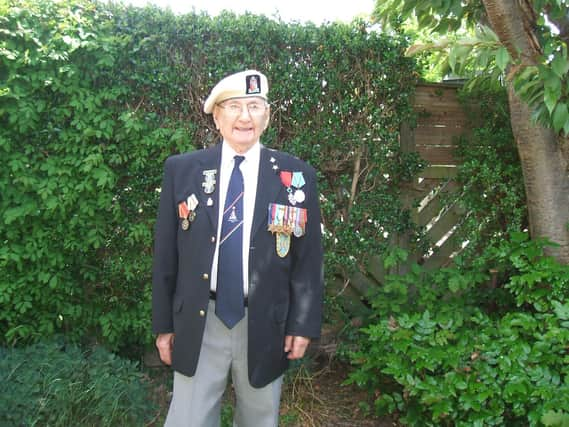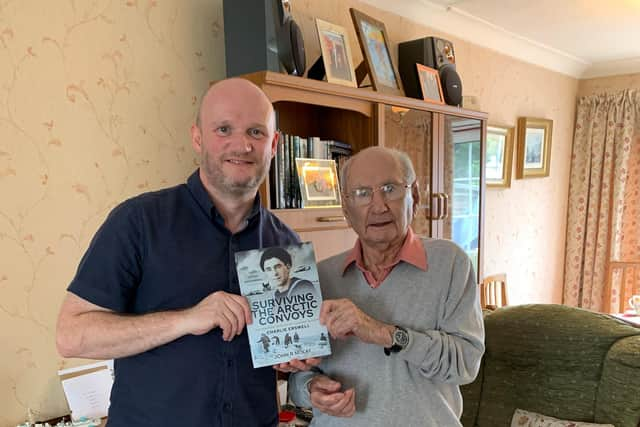Surviving the Arctic Convoys - a veteran's story


Leading Seaman Charlie Erswell, of Horbury, now aged 97, served on the Arctic Convoys during World war Two, escorting merchant ships taking essential war supplies to the Russian ports of Murmansk and Archangel between August 1941 and May 1945,
It was dangerous work. As well as having to contend with U-boat and Luftwaffe attacks, the sailors endured extreme sea conditions and freezing cold weather, having to clear ice and snow from the ships in temperatures as low as minus 30 degrees Celsius. In all, 85 merchant ships and 16 warships were lost.
Advertisement
Hide AdAdvertisement
Hide AdMr Erswell's story has been told by Wigan author John R McKay in his book Surviving the Arctic Convoys: The Wartime Memoir of Leading Seaman Charlie Erswell.


Mr McKay is more widely known for his fiction and it was his novel The Worst Journey In The World about the Arctic Convoys that prompted Mr Erswell to get in touch to congratulate him on its accurate portrayal of the conflict.
The two met up and Mr McKay agreed to record Mr Erswell's wartime memories before they were lost.
Mr Erswell was brought up on the coast in Berwick-upon-Tweed and joined the Royal Navy at the first possible opportunity on his 18th birthday.
Advertisement
Hide AdAdvertisement
Hide AdHe was the turret trainer in B turret on HMS Milne and later worked in the director (above the bridge) on HMS Savage.


He did five trips to Russia and five back and shared stories with Mr McKay of the incredible risks and dangers they faced carrying out their task.
Mr Erswell said: "Arctic conditions ensured that less than ten minutes in the Barents Sea meant death from exposure even if rescued.
"Mountainous seas of 40 ft were commonplace and decks frozen like skating rinks made the dash to 'action stations' a risk in itself.
Advertisement
Hide AdAdvertisement
Hide Ad"There was only a 50:50 chance of reaching Murmansk, and when finally you did get there and sat down to the first hot meal in a fortnight, guess what? Action stations sounded again and the enemy aircraft came over to bomb the survivors at anchor."
Out of three years' service Mr Erswell spent four months in the Mediterranean, four months in and around the Atlantic and four months supporting the D-Day landings, which meant a medal for each.
However, for the two years spent in far more hazardous Arctic waters, it was not until 2012, 67 years later, that the government agreed to the award of the Arctic Star.
Mr Erswell paid tribute to the merchant seaman who served alongside the Royal Navy. He said: "Many of the crews in the merchant ships died horrible deaths in freezing oil-covered Arctic waters, to say nothing of a few survivors who told us that losing their ships meant their pay was stopped immediately to them and their dependants back home."
Advertisement
Hide AdAdvertisement
Hide AdOn May 9, 2014 Mr Erswell and 19 shipmate veterans who had sailed on the Russian convoys travelled to London to be greeted by Russian veterans and presented with the Ushakov medal - the highest Russian naval award.
Mr Erswell said: "The Ushakov medal, together with its citation, is a true campaign medal and I feel it adequately makes up for my three years escorting convoys to Archangel and Murmansk on the two destroyers HMS Milne and HMS Savage,
After he was demobbed in 1949 Mr Erswell worked in engineering. For the 12 years before his retirement at 65 he manufactured artificial limbs in Leeds.
He is married to his second wife Betty and between them they have three children, several grandchildren and great grandchildren.
For more information about the book visit https://johnrmckay.com/